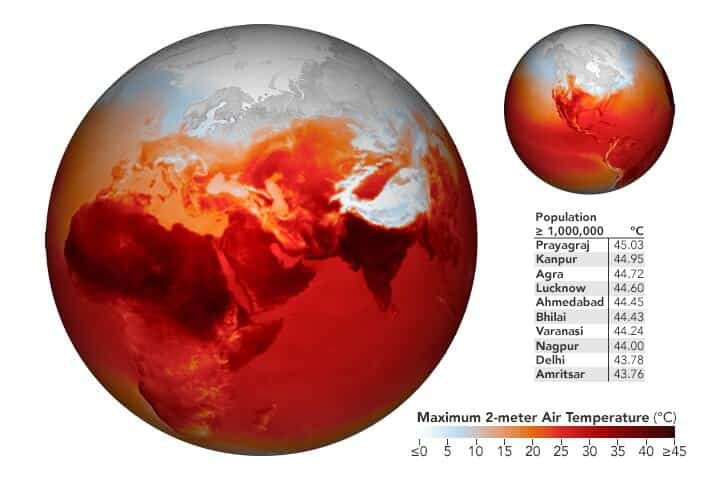Heat waves are common in India in spring and early summer, especially in May, which is usually the hottest month. But they are usually tempered by the beginning of the monsoon season from late May to September; This time they went ahead and extended; 12 of the last 15 years have been the hottest in the Indian subcontinent

A severe heat wave in mid-to-late April 2022 pushed temperatures 4.5 to 8.5 degrees above normal in eastern, central and northwestern India — just weeks after the country recorded its hottest March since the government's meteorological department began keeping records more than 120 years ago.
On April 27, 2022, the highest temperature in India, 45.9 degrees, was recorded in Prayagri in Uttar Pradesh. The previous day, a record high of 45.1 degrees was reported in Barmer in western Rajasthan in northwest India, according to the India Meteorological Department. In many other places temperatures of 42-44 degrees were recorded.
The map above shows a model of air temperatures on April 27, 2022. Its source is the Goddard Earth Observing System (GEOS) model, and it represents air temperatures at a height of two meters.
The results of the heat wave include heat-related illnesses, poor air quality, less rainfall and smaller crops. In addition, demand for electricity has soared and coal inventories have fallen, causing India's worst power shortage in six years. In the northern parts of Uttarakhand and Himachal Pradesh, the snow in the mountains is melting fast. In addition, more than 300 large forest fires were burning across India on April 27, according to the Indian Forest Service. Nearly a third of them were in Uttarakhand.
A bump in the jet stream and a dome of high pressure have left a mass of air that is warmer and drier than normal for the season over India. The heat wave continued for many days into the month of May.
Heat waves are common in India in spring and early summer, especially in May, which is usually the hottest month. But they are usually tempered by the beginning of the monsoon season from late May to September. The number of spring heat waves is increasing, according to India's Earth Sciences Ministry, with 12 of the country's 15 hottest years on record since 2006. A heat wave in June 2015 killed more than XNUMX people.

One response
Exercises in simple logic:
1. The climate changes expressed in forms, hunger and death are caused by the use of oil as an energy source and by polluting industries (of course) + 2. The polluting industries and oil producers are in the hands of tycoons and oligarchs. Conclusion: tycoons and oligarchs are a danger to humans.
+ Tycoons and oligarchs grow in a society that advocates and encourages unbridled capitalism. Conclusion: Capitalism kills.
samples; 1. The slave trade in capitalist England. 2. Flooding the Chinese Empire in the 19th century with opium by the English to crush their economy. 3. Corporations that sell poison like the tobacco companies or Coca Cola. 4. The various arms dealers. more and more..
Capitalism kills. And please father, don't censor me. I am writing to warn you